Victoria
Hospital
78 Coombe Road, Kingston-on-Thames
Medical
dates:
Medical
character:
Acute. Later, gynaecology
The
Kingston and Maldon Victoria Hospital - a red brick building with 44
beds - was opened in December 1898 by the Duke of Cambridge.
It became known locally as the Victoria Hospital, or even 'the Vic'.
After WW1 a wooden Army hut was built in the grounds of the Hospital and was adapted for use as a clinic. It opened on 24th November 1919 as the Kingston Red Cross Curative Post and Orthopaedic Clinic for disabled ex-servicemen still requiring care. The hut was well-heated, and massage and electrical treatments were provided without charge, but the costs of treatment were high and there was a constant need to raise money. The Clinic was managed by the Surrey/90 (Surbiton), Surrey/12 (Wimbledon) and Surrey/136 (Cheam) Voluntary Aid Detachments. The catchment area included Hampton, Molesey, Leatherhead, Epsom, Malden, Wimbledon, Richmond and Kingston.
The Clinic continued in operation until 1928, by which time the Red Cross had also opened an orthopaedic clinic for crippled children.
In 1929 the front garden of the Hospital was reconstructed to meet the requirements for an enlarged drive.
By 1932 patients were being referred to the Red Cross Clinic from the Central Red Cross Clinic for Rheumatism in Peto Place, as it was a shorter distance from their homes. By 1935 the Red Cross hut had been in existence for 17 years, run by Mrs C. Carr Dodds, the officer-in-charge.
In 1948 the Hospital joined the NHS, together with its larger neighbour on the opposite side of Coombe Road, the Kingston Hospital.
In 1950 the Regional Hospital Board decided that the Victoria Hospital should cease to admit general patients, but should become the gynaecological unit of the Kingston Hospital. The medical staff of the Victoria hospital resisted this, fearing the loss of the personal relationship between doctor and patient. Forty patients were even admitted 'illegally' when the deadline had passed. The Chairman of the Medical Staff Committee, Dr Thomas Morgan, stated that the doctors were prepared "to go to prison rather than give in to dictatorial instructions". Seven hundred letters of support arrived from all over England, supporting the rebellion. A local chemist offered £25 worth of goods if the NHS cut off medical supplies, while one firm offered to sterilise instruments for free. The British Medical Association demanded a public enquiry, stating that the Regional Hospital Board "appears to be flouting public opinion in the district".
At the end of November 1950 a public meeting in the 1200-seater Coronation Hall, Kingston, attracted 1500 indignant citizens. The doctors demanded a full enquiry and the next day signatures were collected for a petition to be sent to the House of Commons.
The doctors were not objecting to socialised medicine - after all, all 26 of them were employed by the NHS - but were concerned about the threat to the doctor-patient and doctor-specialist relationships. The GPs were able to bring a patient to the Victoria Hospital and provide treatments themselves, or refer the patient to a specialist and have personal contact with him or her, while still keeping in touch with the patient. In large hospitals these relationships did not exist. The GPs feared that if they were kept out of hospitals, standards of care would fall.
But, as with most other local attempts to maintain the status quo of their hospital, the attempt failed and the Victoria Hospital was converted to become the gynaecological unit of the Kingston Hospital.
By 1954 the Victoria Hospital had been renamed the Victoria Ward, and all non-gynaecological patients were referred to the Kingston Hospital on the opposite side of Coombe Road. However, a children's ward with 11 beds remained, mainly for patients undergoing removal of tonsils and adenoids. The Pathology Department and the dispensary closed, as did the kitchens (all meals for in-patients were supplied by the kitchens at the Kingston Hospital). The X-ray Department stayed open, providing a service for GP examinations.
In 1981 the Victoria Hospital building was taken over by the Surbiton branch of the Royal Eye Hospital.
It became known locally as the Victoria Hospital, or even 'the Vic'.
After WW1 a wooden Army hut was built in the grounds of the Hospital and was adapted for use as a clinic. It opened on 24th November 1919 as the Kingston Red Cross Curative Post and Orthopaedic Clinic for disabled ex-servicemen still requiring care. The hut was well-heated, and massage and electrical treatments were provided without charge, but the costs of treatment were high and there was a constant need to raise money. The Clinic was managed by the Surrey/90 (Surbiton), Surrey/12 (Wimbledon) and Surrey/136 (Cheam) Voluntary Aid Detachments. The catchment area included Hampton, Molesey, Leatherhead, Epsom, Malden, Wimbledon, Richmond and Kingston.
The Clinic continued in operation until 1928, by which time the Red Cross had also opened an orthopaedic clinic for crippled children.
In 1929 the front garden of the Hospital was reconstructed to meet the requirements for an enlarged drive.
By 1932 patients were being referred to the Red Cross Clinic from the Central Red Cross Clinic for Rheumatism in Peto Place, as it was a shorter distance from their homes. By 1935 the Red Cross hut had been in existence for 17 years, run by Mrs C. Carr Dodds, the officer-in-charge.
In 1948 the Hospital joined the NHS, together with its larger neighbour on the opposite side of Coombe Road, the Kingston Hospital.
In 1950 the Regional Hospital Board decided that the Victoria Hospital should cease to admit general patients, but should become the gynaecological unit of the Kingston Hospital. The medical staff of the Victoria hospital resisted this, fearing the loss of the personal relationship between doctor and patient. Forty patients were even admitted 'illegally' when the deadline had passed. The Chairman of the Medical Staff Committee, Dr Thomas Morgan, stated that the doctors were prepared "to go to prison rather than give in to dictatorial instructions". Seven hundred letters of support arrived from all over England, supporting the rebellion. A local chemist offered £25 worth of goods if the NHS cut off medical supplies, while one firm offered to sterilise instruments for free. The British Medical Association demanded a public enquiry, stating that the Regional Hospital Board "appears to be flouting public opinion in the district".
At the end of November 1950 a public meeting in the 1200-seater Coronation Hall, Kingston, attracted 1500 indignant citizens. The doctors demanded a full enquiry and the next day signatures were collected for a petition to be sent to the House of Commons.
The doctors were not objecting to socialised medicine - after all, all 26 of them were employed by the NHS - but were concerned about the threat to the doctor-patient and doctor-specialist relationships. The GPs were able to bring a patient to the Victoria Hospital and provide treatments themselves, or refer the patient to a specialist and have personal contact with him or her, while still keeping in touch with the patient. In large hospitals these relationships did not exist. The GPs feared that if they were kept out of hospitals, standards of care would fall.
But, as with most other local attempts to maintain the status quo of their hospital, the attempt failed and the Victoria Hospital was converted to become the gynaecological unit of the Kingston Hospital.
By 1954 the Victoria Hospital had been renamed the Victoria Ward, and all non-gynaecological patients were referred to the Kingston Hospital on the opposite side of Coombe Road. However, a children's ward with 11 beds remained, mainly for patients undergoing removal of tonsils and adenoids. The Pathology Department and the dispensary closed, as did the kitchens (all meals for in-patients were supplied by the kitchens at the Kingston Hospital). The X-ray Department stayed open, providing a service for GP examinations.
In 1981 the Victoria Hospital building was taken over by the Surbiton branch of the Royal Eye Hospital.
Present status (June 2008)
The Royal Eye Unit moved to the Kingston Hospital site in 1995 when the site was sold. The Victoria Hospital was demolished and the site now contains an office block, a care home and housing.
The Royal Eye Unit moved to the Kingston Hospital site in 1995 when the site was sold. The Victoria Hospital was demolished and the site now contains an office block, a care home and housing.

The office block as seen from Norbiton station
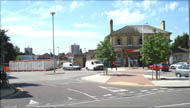
Norbiton station is directly across from the site of the Hospital
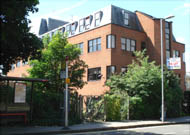
The office block as seen from Coombe Road
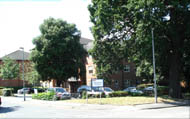
The Kingston Care Home, built in a new Close, with housing on the left


A cottage on the south side of Coombe Road was donated to the Hospital in 1908 by W.E. Green, Esq., of Devonshire House, Twickenham.
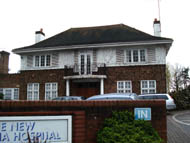
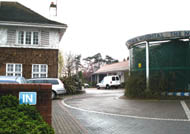
The New Victoria Hospital in Coombe Lane West.
The drum-shaped building on the right of the entry drive bears the name of the Hospital
In 1951 funding was raised to support a smaller 20-bed independent hospital, with the consultants not charging for their services. In 1958 the New Victoria Hospital opened at 184-188 Coombe Lane West, a mile or so away from the site of the Victoria Hospital. It was a registered charity until the Hospital was sold to a group of private investors in 2007.
(Author unstated) (undated) Red Cross work in Surrey 1918-1919. British Red Cross Surrey Branch.
(Author unstated) (undated) Red Cross work in Surrey 1919-1920. British Red Cross Surrey Branch.
(Author unstated) 30 October 1954 Revival of Kingston Victoria Hospital: result of voluntary effort. British Medical Journal 2 (2597), 158.
www.time.com Article dated 1950 (Accessed June 2008)
www.time.com Article dated 1951 (Accessed June 2008)
Return to alphabetical list
Return to home page